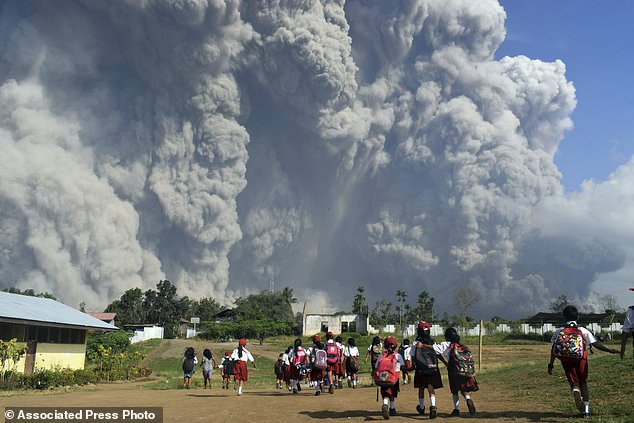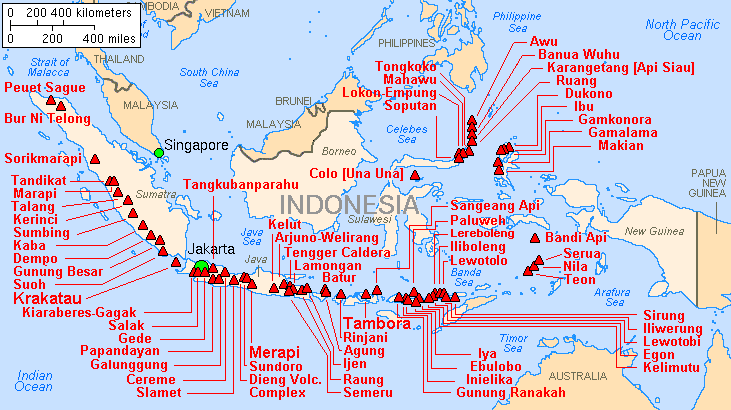
School children walk as Mount Sinabung erupts in Karo, North Sumatra, Indonesia, Monday, Feb. 19, 2018. Rumbling Mount Sinabung on the Indonesian island of Sumatra has shot billowing columns of ash more than 5,000 meters (16,400 feet) into the atmosphere and hot clouds down its slopes. The volcano, one of three currently erupting in Indonesia, was dormant for four centuries before exploding in 2010. (AP Photo/Sarianto)
redo Jump to...
print Print...
(by Ed Adamczyk, UPI and staff reporters at AFP in Karo, North Sumatra, Feb. 19) — Indonesia’s volcanic Mount Sinabung erupted on Monday, sending ash and smoke about 16,000 feet into the air.
No one lives inside a previously announced no-go zone around the volcano. But hundreds of houses outside the 4.3 mile danger zone were covered in volcanic ash.
No injuries were reported, but officials have distributed face masks and urged local residents and tourists to stay indoors to avoid respiratory problems, said local disaster mitigation agency official Nata Nail Perangin-angin.
“In some villages the visibility was barely five metres (16 feet) after the eruption — it was pitch black,” Perangin-angin added.
Mount Sinabung, on the island of Sumatra, erupted in 2010 for the first time in 400 years and has been regarded since as an active volcano. It erupted again in 2013. An eruption the following year killed 16 people, and another in 2016 killed seven.
Monday’s eruption lasted for nearly five minutes.
Rain is expected in the area on Tuesday and Wednesday, which can combine with ash to make slippery travel conditions and increase the possibility of roof collapses and the volcanic version of mudslides, Accuweather reported on Monday. Wet ash also is capable of conducting electricity, which can lead to power failures.
The ash cloud could impact airplane flights around northern Sumatra, to southern Thailand until Tuesday, when the cloud is expected to dissipate. The Australia-based Darwin Volcanic Ash Advisory Center set its aviation alert level to red after the eruption, warning pilots to avoid the area.
Indonesia is home to around 130 volcanoes due to its position on the “Ring of Fire,” a belt of tectonic plate boundaries circling the Pacific Ocean where frequent seismic activity occurs.
Compiled from reports at United Press International (UPI) and Agence France-Presse (AFP).
Map of Indonesian volcanos – from Wikipedia:
Questions
1. For INDONESIA, give the following information:
- capital
- location/the countries that share its borders
- the religious breakdown of the population
- the type of government
- the chief of state (and head of government if different) If monarch or dictator, since what date has he/she ruled? – include name of heir apparent for monarch
- the population
Find the answers at the CIA World FactBook website. For each country, answers can be found under the “Geography” “People” and “Government” headings.
NOTE: Before answering the questions below, read the info under “Background” and watch the videos under “Resources.”
2. For INDONESIA:
a) list the who, what, where and when of the news item
b) Before 2010, when was the last time Mt. Sinabung erupted?
c) No injuries were reported from Monday’s eruption. What negative effects might occur as a result of this latest eruption?
d) What is the Ring of Fire?
Background
Indonesia is the world’s third-largest democracy, the world’s largest archipelagic state, and home to the world’s largest Muslim population.
- Indonesia’s approximately 260 million people make it the world’s fourth-most populous nation.
- The island of Java, roughly the size of New York State, is the most populous island in the world (141 million, 2018 est.) and one of the most densely populated areas in the world.
- Indonesia includes numerous related but distinct cultural and linguistic groups, many of which are ethnically Malay.
- Since independence [in 1945], Bahasa Indonesia (the national language, a form of Malay) has spread throughout the archipelago and has become the language of most written communication, education, government, business, and media. Local languages are still important in many areas, however.
- English is the most widely spoken foreign language.
- Although constitutional guarantees of religious freedom apply to the six religions recognized by the state, namely Islam (87.2%), Protestantism (4.1%), Catholicism (2.9%), Hinduism (1.8%), Buddhism (about 1%), and Confucianism (less than 1%), Christian persecution by Muslims takes place and has been increasing over the past several years. (Do an internet search “Christian persecution in Indonesia” for more information)
Daily “Answers” emails are provided for Daily News Articles, Tuesday’s World Events and Friday’s News Quiz.




